Gail asked: How do I clean unfinished wood? I think it’s pine. Our dining room table has wine and food stains on it. I once used olive oil, but it did not remove the stains that well. It’s unfinished wood, so I’m not sure how to clean it and also protect the wood.
If  you’ve had the misfortune of finding unwanted stains on your unfinished wood, you’ve learned firsthand why experts recommend a protective coat over wood surfaces. Whether you’ll ever be able to remove the stain depends on a couple of factors, namely the type and condition of the wood and the kind of stain you’re dealing with, but under the best of circumstances many stains will be permanent. Still, you may improve or eradicate the stain by following these methods.
you’ve had the misfortune of finding unwanted stains on your unfinished wood, you’ve learned firsthand why experts recommend a protective coat over wood surfaces. Whether you’ll ever be able to remove the stain depends on a couple of factors, namely the type and condition of the wood and the kind of stain you’re dealing with, but under the best of circumstances many stains will be permanent. Still, you may improve or eradicate the stain by following these methods.
Removing Oil Stains
You Will Need:
- An absorbent powder (choose one):
- Baking soda
- Corn starch
- Corn meal
- Wheat germ
- A vacuum
- Hydrogen peroxide (optional)
Steps to Remove the Oil Stain:
- Cover the stain with a thick pile of absorbent powder. (Choose a powder from the list above. Any will work, but it is best to choose one what is closest in color to the color of the wood in case some of it gets into the grain of the wood and can’t be removed.)
- Leave the powder for a few hours or overnight. If needed, cover the plastic wrap to prevent the powder from blowing off in the wind or stop a cat from walking through it.
- Vacuum or sweep up the powder.
- This can be repeated as many times as needed to fully remove the stain.
- One site user suggests applying a small amount of mineral spirits to the stain first using a cloth, then covering with the powder. Try doing that if using the method dry (without mineral spirits) hasn’t worked. Be sure to wear gloves and ventilate the area when working with mineral spirits.
- Another site user reported having success using hydrogen peroxide. Apply the peroxide onto a cloth, then blot the stain.
Removing General Stains
You Will Need:
- Gloves
- Mineral spirits
- A cloth
Steps to Remove the Stains:
- Always wear gloves and ventilate the area well when working with mineral spirits.
- Wet a cloth with a small amount of mineral spirits.
- Wring the cloth out so it’s only damp, not dripping.
- Blot the stain with the damp cloth until it is gone.
- Add more mineral spirits as needed.
Removing Difficult Stains
This process should only be used on solid wood. Wood veneer might be too thin to sand and you would risk sanding through the veneer to the plywood.
You Will Need:
- Fine grit sandpaper
Steps to Remove the Stain:
- Using fine grit sandpaper, lightly sand the surface.
- Pause frequently to wipe away the dust and check your progress.Also, ensure you are not sanding so much wood away that you leave a depression.
- Repeat until the stain is gone or until you start to wear away the wood.
- If the sanding is noticeable, lightly scuff the rest of the surface with the sandpaper so it matches.
Additional Tips and Advice
- Pine is a soft wood and quickly absorbs stains. Harder woods are more likely to only be stained at the surface, therefore increasing your chance of successful stain removal.
- If you get the stain out, consider finishing the wood with a clear protective finish. If you can’t get the stain out, consider applying a wood stain over the entire surface to “hide” the unwanted color.
- If the wood is just generally dirty, check out our guide How to Clean Unfinished Wood.


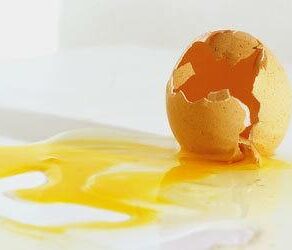
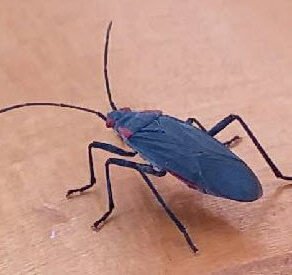
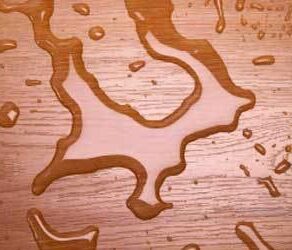
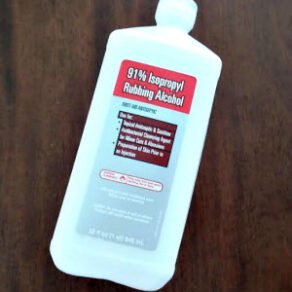
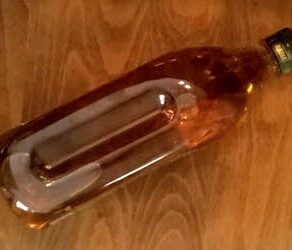


I have been told not to sand unfinished wood if there is oil or grease on it. The oil or grease will be “burned” into the wood.
I am making an oak table, and one of the boards has a stain on it. How can I get it out? It is too big to put in a planer, and I have sanded all I can. I could use some help with this.
I have an old, unfinished steamer trunk that has damp, sticky areas on the front and back edges of the lid. Is there any way to remove this?
I tried this. Turns out the table was finished pine and not unfinished, oops!
Hi
My rubber sole shoes have rubbed onto the new unfinished pine floor boards. I want to varnish the floor, but I want to remove these dirt stains. I moped them with damp mop and some wash up liquid, but the stain is only partly gone. Best wishes from Jim
Hello, I would like to ask a simple way to remove a heat stain on a wood dining table, made from fresh laundry out of dryer. Thank you.
Hi. Please can you tell me how to remove a water stain from untreated oak? Thank you.
Christine,
Removing stains from untreated wood can be very difficult. Thankfully, oak is a hard wood, so the stain is not likely to be as deep in the wood as it would be on pine. Here are some suggestions for removing the water stain:
You may have success with a solution of mild detergent. Mix a few drops of mild detergent in water, agitate the water to create suds, moisten a cloth with the solution and wipe the stain. Then, blot the area dry with a towel. If possible, used distilled water to avoid any mineral deposits. Also, you may want to dust the area with a dry cloth first to prevent any dust from being deposited into the wood by the cleaning solution.
You could also try erasing the stain with an art gum eraser, but be careful not to over-clean the wood.
You can also try using either mineral spirits or trisodium phosphate. Both of these are sometimes used to clean unfinished wood, however, you may want to test them on a hidden area first to look for any adverse effects. Also, follow safety precautions for either chemical (wear gloves and ventilate the area). To use mineral spirits, dampen a rag with the mineral spirits and wipe the stain. For the TSP, you can scrub it into the wood with a scrub brush or old toothbrush, then wash it off with plain water. Blot dry after cleaning.
Another option is to wet (dampen) the entire piece of wood, which will (hopefully) then air dry evenly.
As a last resort, you can use oxalic acid to bleach the stain. There are instructions for this method in the eHow article, “How Do I Remove Water Stains From Unfinished Wood.”
Source: How To Clean Stuff – How to Remove Water Stains from Wood
Source: Canadian Conservation Institute – Care and Cleaning of Unfinished Wood
Source: DoItYoursef.com – How to Safely Clean Unfinished Hardwood Floors
Source: eHow – What to Use to Clean Unfinished Wood Floors
Source: Sawmill Creek – Remove water stain from oak
I tipped over a full bottle of soy sauce on my raw oak kitchen cupboards. I am getting ready to paint, but I need to remove the stain. Seems like it’s pouring out of the seam… HELP!
Diane,
If the actual fluid is the problem (needing to soak up the fluid), try covering the area with an absorbent powder like baking soda or cornstarch. Let the powder sit on the area for a few hours to soak up the fluid, then brush it off. Repeat that as many times as needed to soak up all the moisture.
If the stain color is the problem, try blotting the stain with a cloth dampened with isopropyl alcohol. Soy sauce has an alcohol component to it due to the fermentation process, so alcohol should work well to remove it (the principle of “like dissolves like”). Only use a small bit of alcohol though, and turn the cloth to a fresh area as the stain is transfered to the cloth.
Source: Furniture-EMT.com – Rubbing alcohol and Wood Furniture
Source: Kikkoman – FAQs About Sauces and Mixes
I have an open tread timber staircase. I accidentally spilled cooking oil. The stain has set into the timber. Please help; it looks disgusting. Thank you.
Joan,
Use a grease-fighting dish liquid to try to clean the spot. Mix the soap with some warm water to make suds, scoop the suds onto a scrub brush (only the suds, not the water) and rub the suds into the stains; scrub, rinse by wiping with a damp (not dripping) cloth and repeat. Wipe the area dry afterward.
Another option is to try using mineral spirits. Follow the safety guidelines for the mineral spirits. Moisten a cloth with the mineral spirits and rub the stains. Use a scrub brush if needed. Let the mineral spirits dry on the stains.
Another option is to try TSP (trisodium phosphate). This is a serious cleaner that will require some gloves and eye protection as well, but can be used to remove oils stains and can be used to clean unfinished wood. Only apply a little TSP and scrub it in with a scrub brush, then rinse the area clean and wipe it dry.
Always test a cleaner on a small area first to look for any adverse reaction.
Here’s another option as well: When oil soaks into concrete, what you would do is cover the spill with a 1/4 inch thick layer of an absorbent powder like baking soda, cornstarch or kitty litter. Let the powder soak up the oil overnight or for several hours, remove the powder and repeat the process with fresh powder until all of the oil is removed. I’d probably try this method first since it requires little effort and no liquids. However, sometimes brake cleaner is needed to draw the oil to the top of the concrete so that it can be absorbed more easily. If you find that just covering the stains with the powder isn’t enough after two tries, you could test some brake cleaner on a small hidden area of the staircase to see how it reacts with the wood (definitely test first, as it could damage the wood) and if safe, then try it on a small spot on one oil stain first. Cover the spot with powder after you apply the brake cleaner. Or, if you want to avoid the brake cleaner, try using the powder method after one of the other methods (dish liquid suds, mineral spirits or TSP) has dried if needed.
Source: HowToCleanStuff.net – How to Remove Lotion Oil from Finished Wood article.
Source: eHow – How to Remove Stains from Unfinished Wood Floors
Source: Hardwood Champ – Cleaning Unfinished Wood Floors with Mineral Spirits
Source: DoItYourself – How to Safely Clean Unfinished Hardwood Floors
Source: HowToCleanStuff.net – How to Remove Olive Oil from Concrete and Wrought Iron
I have a raw piece of cherry that I had covered with a sheet. My husband put car parts on top and some of the oil soaked through. I tried mineral spirits and then wiped it off; some came off, but I would like to remove it completely. Any ideas? It was supposed to be sealed and stained and used on my kitchen island. 🙁
Deanna,
You can try using the same techniques that I suggested to Joan above for removing cooking oil stains. Both cooking oil and car oil have the same general cleaning principals. As always though, test any cleaning solution on a small hidden area first to check for any adverse reaction with your item before using it to clean the stain. Good luck!
Please help!! I had sanded my hardwood fir floor while prepping it for a stain and finish when I had to leave unexpectedly. My husband, bless his sweet stupid heart, wanted to surprise me and called in the contractor. The roof went up, drywall, and paint. No one used a drop cloth or protected the floor at all. There’s tar, dirt, sawdust, drywall mud, burn marks, grime, and God knows what else CAKED onto the floor. I have no idea what to do. I used up most of my flooring budget renting a sander and getting all the product in the first place, and I’m uneasy about the idea of sanding again because I don’t want to over sand.
I have a dresser and drawers that are made of unfinished cedar wood. How do I clean this? There are no stains; it’s just old.
Check it out! We’ve answered your question! Yay!
We sanded our oak wood floors in the kitchen and got some drops of water on it prior to staining. We sanded lightly and then went on to apply our first coat of stain… the spots appeared and it looks horrible. Help!
Good advice, thank you!
I have a raw black walnut electric guitar body I made that had old orange soda spilled down the front. It is still thick and sticky over a year later. What would you recommend for removing the “sugar/soda sticky river” before I prepare it for finishing? I really put a lot of work into this guitar body and want to make it as nice as possible. Thank you! Phil
Phil,
Here’s some suggestions. First, you need to use something to get the stickiness and residue off the wood. I would try dish liquid. Mix some mild (bleach-free) dish liquid in water (preferably distilled water to prevent any mineral deposits) to make suds. Get a cloth slightly wet and wring it out well so that it is only barely damp. Wipe the suds off the surface of the water onto the cloth without getting any extra water on the cloth, then use the cloth to rub away the sticky residue. Once the residue is gone, wipe the area with a soap-free spot on the damp cloth to remove the soap residue on the wood. Then, pat the area dry with a towel and use a fan or blow dryer on cool air to dry the area fully. Leaving the wood wet can cause warping, cracking, or water stains.
If there is a dye stain that remains from the orange dye in the soda, try mineral spirits or turpentine. You could also try isopropyl alcohol. Don’t use rubbing alcohol though, as that often contains other ingredients, including dye.
If there is a brown stain that remains, it’s from the sugar in the soda oxidizing over time. Those stains can be difficult to remove from any surface, however, turpentine might work to remove it.
Remember to always test a cleaning solution on a small hidden spot first to look for any adverse reaction.
Good luck!
Source: HowToCleanStuff.net – How to Remove Beer Stains from Clothing
I sanded an old desk and had not yet stained it when my son accidently dripped some laundry detergent on it. It now has a spot on the desk top that looks wet (darker). I don’t want to stain it a dark color but was planning on staining it teak — like the mid-century furniture color. I would love to be able to remove this one dark spot off the table top but I don’t know if it’s safe to use water to wash it out because I’m worried about causing water damage to the wood. Could you give me some advice? Thanks!!
Ella,
You can try the methods in the article How to Remove Lotion from Bare Wood.
If those don’t work, try the method above for removing oil stains. The powder should soak up the detergent out of the wood, and that way you won’t need to use any water. Good luck!
Melanie,
I haven’t had time to return to work on my project until today and I just wanted to return to this site and thank you. Using a warm iron with a piece of cloth worked! I was amazed. I would have never come up with this idea as I always avoid heat and stains… but it totally removed the darker spot and even as I tried to look for it, it’s completely not noticeable. I hope it stains well. Thanks!
Can anyone help?
I recently sanded pine floor boards in prep for stain and oiling. But before I finished them, I washed the walls with sugar soap to get rid of the sawdust and to prep for painting… the splashes of water from the sugar soap bucket have dried into the pine a different awful green colour. I’ve tried washing the wood to wash the sugar soap off, but it hasn’t helped. 🙁 Can anyone offer any advice? Thanks. xx
We have a teak table on our boat. Over the winter a can of OFF was left on it. This product removed the finish and left a stain. I stripped the table with a paint/varnish remover and have been left with a white spot where the wood is more bleached than the rest of the table. How can I balance this discoloration, before I apply varnish?
Julie,
Here are some remedies you can choose from.
1) Sand the area to remove the stain.
2) Use wood bleach to bleach the rest of the table to match (put masking tape over the stained area so you don’t double-bleach that area).
3) You can try staining just the spot with a penetrating oil like teak oil or wood stain that is teak color. If you decide to use the teak oil, apply it only to the stain with a paint brush. Keep in mind that the teak oil will continue to darken over time unless you get one designed not to (with UV blockers), so you may want to do a second application going over the entire table this time to ensure the color remains the same over time.
Good luck!
Source: BoatUS – Teak Care